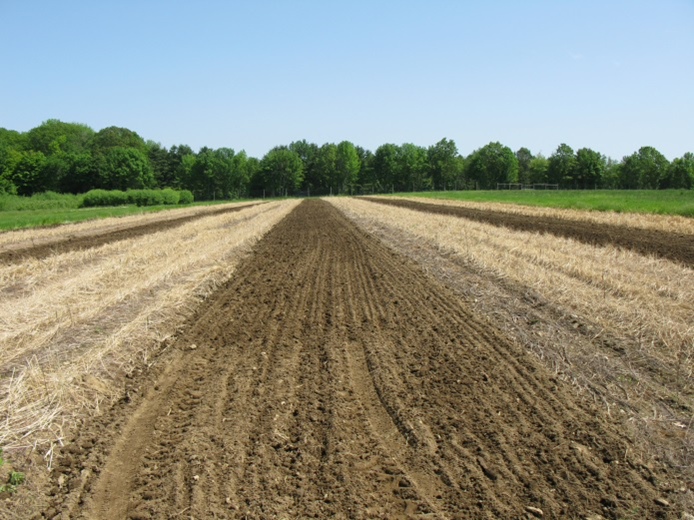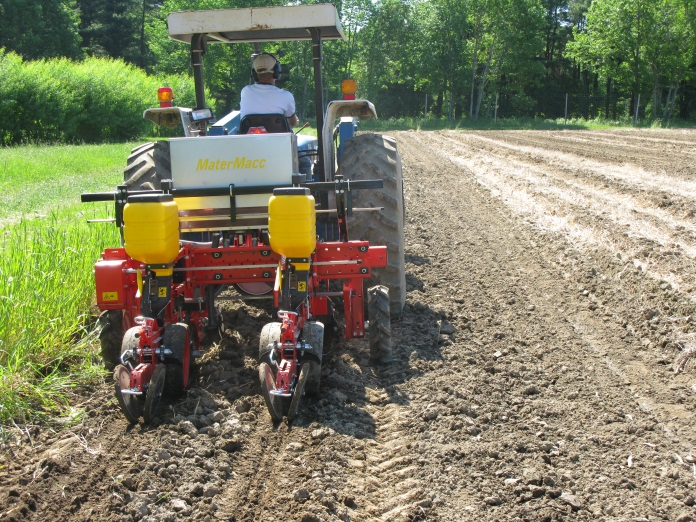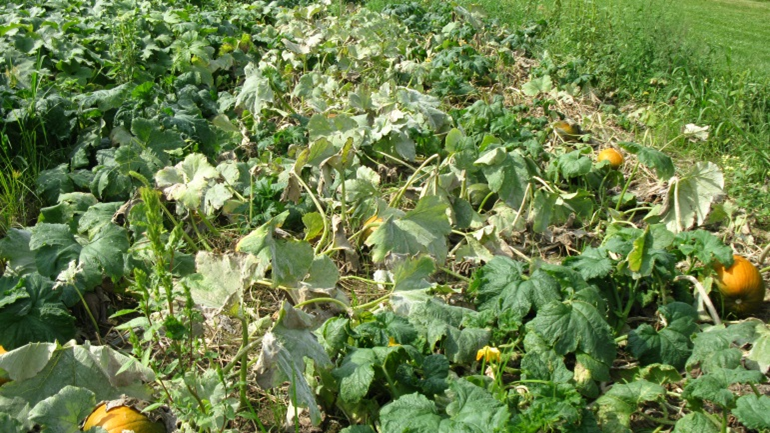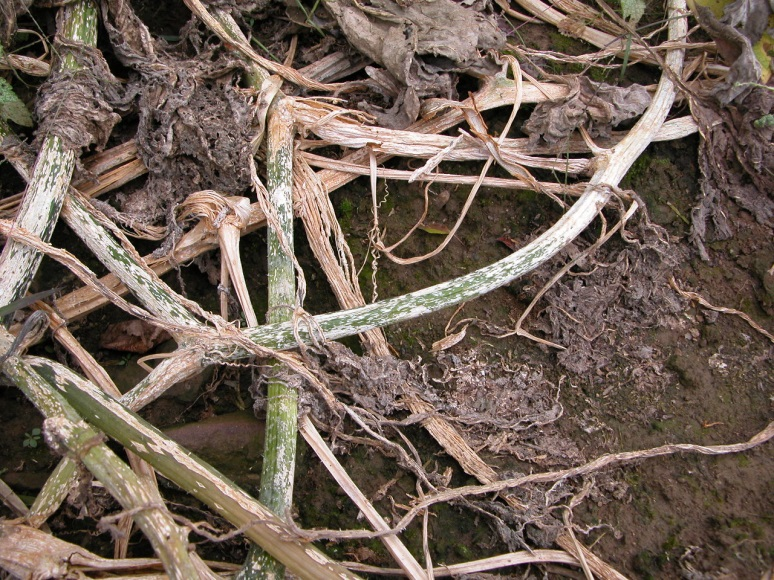By Jude Boucher, UConn Extension Educator, Commercial Vegetable Crops
Introduction (Current Fungicide Program)
Before I can talk about this experiment, I need to remind you of how and why we use specific fungicides on pumpkins. I’ve talked about fungicide sprays on pumpkins before and mentioned how there are four annual diseases that we can protect our pumpkins from with these products: powdery mildew (PM), Plectosporium blight (Plecto), black rot (BR) and Downy Mildew (DM). We tend to design a fungicide spray schedule around PM, which is the most common disease on cucurbit crops and often the first to show up. The basic idea is to slow disease spread with the fungicides by limiting spore formation, new leaf infections, and stem and fruit problems, so that you maximize your yields and net profits.
Conventional tillage and rye-mulch strips for DZT
Systemic fungicides, which move through the plant, usually provide the most effective control of PM because it is impossible for any sprayer to provide good coverage, where the infection first occurs, on the underside of the lower, older leaves in a waist-high pumpkin patch. As part of our resistance management strategy we use each systemic family only one time each season. That’s because, unlike with protectant fungicides, that have several modes-of-action to stop infection, systemics tend to have a single mode-of-action which is easily skirted by the billions of spores that are encountered after each spray. To help slow resistance, and to provide control of Plecto and BR, we also add a protectant to the tank mix during each application. So our spray program in recent years has gone something like this: Quintec + Bravo (i.e. chlorothalonil), Procure + Bravo, Pristine + Bravo, and then we switch to two protectants for the remainder of the sprays (sulfur + Bravo). You could also use the Pristine in your second application and mix it with the protectant sulfur, to rest the Bravo, while still providing good protection against PM, Plecto and BR. An additional product that works on water molds may be added to the spray mix late in the season if or when DM shows up, but we will talk about applications for water molds another time.
Planting pumpkins in conventional and DZT plots.
To determine when to make the first application, scout 50 lower leaves each week after the plants run, and spray when you find the first small, round, colony of white powdery mildew spores (usually on the underside of the leaf). Then, we usually continue to make applications at 10-day intervals until mid-September.
Spray Interval and Tillage Experiment
Now that you remember the fungicide program, here is the “spray interval” experiment that we ran at the UConn Plant Science Research Farm during the last two summers. Our starting hypothesis was that with a resistant pumpkin variety, you should be able to stretch your spray interval and still produce marketable pumpkins.
Pumpkin with damaged (unmarketable) handle.
We used a split-plot design with 2 tillage methods (Fig. 1) and 4 spray intervals, and replicated the 15’ X 40’ plots 4 times each, for a total of 32 plots in each experiment. We planted 3 rows of pumpkins per plot that were spaced 5 feet between rows (Fig. 2) and 2 feet between plants in the row. Half the pumpkins were planted on conventionally-tilled strips prepared with a plow, harrow and cultipacker, while the other half were planted on a narrow (8”), deep zone tilled seedbed through a killed rye cover crop. The spray interval treatments consisted of no spray, 21 days, 14 days and 10 days.
In 2011, we conducted two similar but separate experiments with different PM-resistant pumpkin varieties: ‘Gladiator’ and ‘Magic Lantern’. In 2012, we ran a single experiment with Gladiator. Pumpkins were planted on June 6, 2011 and June 8, 2012 and harvested September 12 and 16 the first year, and September 7 the second year.
Unsprayed pumpkin plot with powdery mildew damage.
The first spray for PM was applied on August 12, 2011 and on July 27, 2012. The same sequence of fungicides mentioned above were used in each treatment, except that we used the chlorothalonil brand Initiate instead of Bravo. We did not complete the sequence of 3 systemics + protectant applications before harvest for the 21d treatment either year (only two applications were made to these plots). In 2011, total rainfall for the year exceeded 63 inches in Storrs, with the remnants of Hurricanes Irene and Lee adding to the extreme wetness in late August and early September, while 2012 had “normal” rainfall for the season and year (42.4 inches for the year).
Powdery mildew damage to leaves (Fig. 3), Plecto damage to vines (Fig. 4), and fruit stem or handle (Fig. 5) damage were rated on a scale of 0-5 or 0-3 for no damage to severe damage (i.e. leaf death or no handle). The fruit were weighed at harvest and the percent marketable fruit were calculated. A marketable fruit was considered to be at least 3 pounds and have a stem rating of 2 or less (medium to no damage).
2012 (“Normal”-Rainfall-Season Results)
There was not much difference between pumpkins grown with the two tillage methods for any of the factors measured in 2012. However, there were big differences between the different spray intervals. The 10d (average leaf rating of 2) interval provided better PM control than the 14d or the 21d (rating of 3), which did better than no spray (rating of 4.3). Both the 10d and the 14d spray interval provided better vine protection from Plecto than the 21d interval or no spray. Again, both the 10d and 14d spray interval provided better stems (handles) than the 21d interval, which was better than the treatment that did not get sprayed, where most handles were not marketable. Average fruit weight ran about 13 pounds for the 10d and 14d interval plots and about 11 pounds for the 21d and no spray treatments. Almost all (95-100%) of the fruit were marketable for the 10d and 14d spray intervals, while 75-90% were marketable for the 21d interval (90% in the DZT plots), and only 40-50% were marketable for the unsprayed plots. We could conclude that in a year with normal rainfall, even with a resistant variety like Gladiator, we shouldn’t stretch the spray interval to more than 14 days. Since both the 10d and 14d treatments received 4 applications in 2012, there was no reduction in fungicide use when increasing the interval by 4 days. However, since pumpkins generally yield about 20 tons per acre, at a retail price of $0.50/pound in CT, you would make $19,000-$20,000 gross profits (roughly $6,500 wholesale at $0.17/lb.) by using fungicides on a 10d or 14d interval, compared with half that amount or less if you didn’t use fungicides.
2011 (Wet-Season Results)
I’ll shorten the 2011 story by just talking about the percent marketable fruit results, because in the end, that is what will determine how much money you will make from your pumpkin patch. With all the rain in August and September of 2011, improving drainage with deep zone tillage (DZT), and possibly having a rye mulch for the fruit to grow on, made a big difference compared with growing pumpkins on bare ground with conventional tillage.
Plectosporium damage to vines.
Between 80-95% of the Gladiator fruit were marketable in the sprayed DZT plots, but only 65-70% were marketable in the sprayed conventionally-tilled plots, while only 50-55% of the fruit were marketable in the unsprayed plots for either tillage method. This is an increase in yields of 15-25% in sprayed DZT versus conventionally-tilled plots. That means that increased yields from as little as 2 acres of retail pumpkins could pay for a new zone builder. A 2008 compaction survey showed that this research farm field was one of the few vegetable fields in the state without a plow pan. Imagine how much better yields might be if you were using DZT on a field with a plow pan (89% of CT vegetable fields) and poor drainage.
Ironically, with more wet weather in 2011, there was not a big difference in marketable fruit between the different spray intervals for Gladiator, as long as they were sprayed (15-40% decrease in yield when left unsprayed).
The wet 2011 season reduced yields for Magic Lantern much more than for Gladiator. For the conventionally-tilled, 14d and 21d spray interval plots, Magic Lantern only yielded 25-35% marketable fruit, compared with 45-70% for DZT plots with the same spray intervals (a yield difference of 20-35%). For Magic Lantern, both tillage methods yielded 60-65% marketable fruit for the 10d interval, but only 5-15% for the unsprayed plots. Spray intervals made very little difference for DZT plots, but a tight schedule (10d) made a big difference for the conventionally-tilled plots. However, the highest gross profit you would have made with this variety, even with DZT, was $14,000 per acre, compared with $19,000 for Gladiator.
Our final conclusions would be that Gladiator performs better than Magic Lantern in a wet year, it pays to DZT in a wet year, it pays to use fungicides any year, and you probably want to stick with a 10 or 14-day spray schedule even with resistant varieties.




